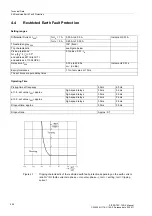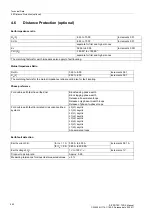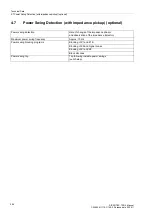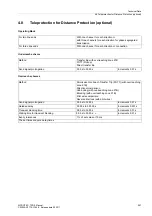
Technical Data
4.1 General
SIPROTEC, 7SD5, Manual
C53000-G1176-C169-5, Release date 02.2011
582
4.1.7
Climatic Stress Tests
Temperatures
1)
UL-certified according to Standard 508 (Industrial Control Equipment)
Humidity
4.1.8
Deployment Conditions
Standards:
IEC 60255-6
Type tested (acc. IEC 60086-2-1 and -2, Test Bd,
-25 °C to +85 °C or -13 °F to +185 °F
Admissible temporary operating temperature (tested for
96 h)
-20 °C to +70 °C or -4 °F to +158 °F (legibility of display may be
restricted from +55 °C or 131 °F)
Recommended for permanent operation (according to
IEC 60255-6)
-5 °C to +55 °C or 23 °F to +131 °F
If max. half of the inputs and outputs are subjected to the max.
permissible values
Limit temperatures for storage
-25 °C to +55 °C or -13 °F to +131 °F
Limit temperatures during transport
-25 °C to +70 °C or -13 °F to +158 °F
Storage and transport of the device with factory packaging!
Limit temperatures for normal operation (i.e. output
relays not energized)
-20 °C to +70 °C or -4 °F to +158 °F
Limit temperatures under maximum load (max. cont.
admissible input and output values)
–5 °C to +40 °C or 23 °F to +104 °F for
1
/
2
and
1
/
1
housing size
Admissible humidity
Annual average
≤
75 % relative humidity;
On 56 days of the year up to 93% relative humidity. Condensa-
tion must be avoided in operation!
It is recommended that all devices be installed so that they are not exposed to direct sunlight nor subject to large fluctua-
tions in temperature that may cause condensation to occur.
The protection device is designed for installation in normal relay rooms and plants, so that electromagnetic immunity is
ensured if installation is done properly.
In addition the following is recommended:
• Contacts and relays operating within the same cabinet or on the same relay board with digital protection equipment,
should be in principle provided with suitable surge suppression components.
• For substations with operating voltages of 100 kV and above, all external cables shall be shielded with a conductive
shield earthed at both ends. For substations with lower operating voltages, no special measures are normally required.
• For substations with lower operating voltages, no special measures are normally required. When removed, many com-
ponents are electrostatically endangered; when handling the EEC standards (standards for
E
lectrostatically
E
ndan-
gered
C
omponents) must be observed. The modules, boards, and device are not endangered when the device is com-
pletely assembled.













































